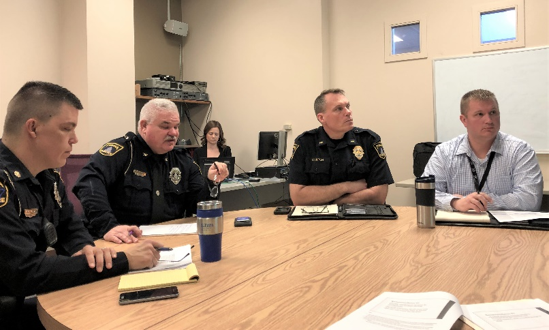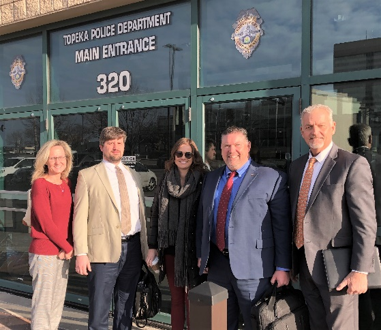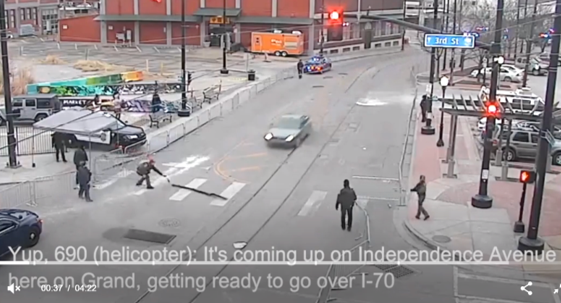|
Use of force in Volusia County, FL, body-worn camera research in Miami Beach, and reducing nonfatal shootings in Topeka, KS
Dear PERF members,
I’m pleased to send you this 2nd issue of “PERF Trending: People, Ideas, and Events.” I want to thank everyone who emailed me with feedback about the first issue last Saturday.
A Florida success story: Let’s start this issue with a good news story from Mike Chitwood, Sheriff of Volusia County, Florida. Many of you know Mike, who began his career with the Philadelphia Police Department and later served for a decade as Chief of Police in Daytona Beach, FL.
In August 2016, Mike was elected Sheriff in Volusia County, having run on a platform of taking a fresh look at the operations of the Sheriff’s Office, in particular regarding use of force.
Mike took office in 2017 and hit the ground running, announcing that PERF would be assisting the Sheriff’s Office with a study of its use-of-force policies, procedures, training, and case files. PERF completed its study in September 2018, and because we had been keeping Mike informed as we conducted our research, by the time we finished our report, Mike had already implemented some of our recommendations. He continued that process in 2019.
Here are the results so far. As you can see, in every category, use of force has declined since Mike took office. Well done, Sheriff Chitwood!
|
|
2015
|
2016
|
2017
|
2018
|
2019
|
|
Officer-involved Shootings
|
7
|
10
|
6
|
3
|
2
|
|
K-9 Apprehensions
|
41
|
31
|
29
|
18
|
17
|
|
Taser Utilized
|
52
|
44
|
39
|
30
|
15
|
|
Total Less-Lethal Force
|
204
|
168
|
138
|
77
|
64
|
|
Total Use of Force
|
211
|
178
|
144
|
80
|
65
|
And some interesting research from Florida about body-worn cameras: This week I also heard from Miami Beach Chief of Police Rick Clements, about an interesting study his department conducted (along with the State’s Attorney Office and the University of Cambridge) regarding body-worn cameras. They looked at BWCs from multiple angles, and here are some of the findings that stood out:
Officers grow to appreciate BWCs: Officers were “generally negative and apprehensive about the usefulness of BWCs prior to the implementation of BWCs in the Miami Beach Police Department, [but] their responses 18 months after full deployment were marked by positivity, receptivity, and acceptance of the utility of BWCs.”
BWCs are helpful in court for certain types of cases: Prosecutors were asked whether BWC footage has proved useful in court. Finding: “The most common types of cases for which prosecutors see value in BWCs are domestic assaults, battery on an officer, and resisting arrest.”
It appears that in these types of incidents, camera footage can help resolve “he said, she said” disputes about what actually happened.
In fact, the study found that “having BWC footage on file increases the chance of a conviction in domestic violence cases by 83% and reduces dismissals in these cases by 23%,” and “in cases of battery of officer, conviction increases by 57% … and dismissals are reduced by 89%.”
Here’s an unexpected finding: For six months, half of the shifts used BWCs marked with a visible yellow sticker, to help members of the public see that the officer was wearing a camera. The other half of the shifts used BWCs without a bright yellow sticker.
PERF did a major project on BWCs and produced guidelines on their use back in 2014, and I remember many people saying, “If the police and the public know they are being recorded, everyone is more likely to be on their best behavior.”
But in Miami Beach, the shifts with yellow stickers had nearly twice as many use-of-force incidents as the no-sticker shifts.
The researchers tried to determine why the stickers “backfired,” and here’s what they found: “The footage shows suspects showing disrespect (without provocation) toward officers wearing BWCs with stickers, versus officers wearing BWCs without stickers.”
It’s hard to imagine what can be going through someone’s mind if they see a video camera and that makes them more likely to become aggressive. But the researchers recommended that “the stickers should be removed from the BWCs as soon as possible.”
Thanks to Rick Clements for this interesting research! I’m hoping Rick will tell us more about it at our Annual Meeting in San Francisco in June.
Working with Topeka PD to reduce nonfatal shootings: Earlier this week, I traveled to Topeka, Kansas with three PERF staffers for a meeting with Topeka Chief of Police Bill Cochran (second from left at the round table photo below) and some of his key people.
With support from the Justice Department’s Bureau of Justice Assistance, PERF is working with Chief Cochran on a project to reduce homicides by focusing on preventing and investigating nonfatal shootings. Nonfatal shootings naturally do not get as much focus as homicides, but they deserve attention, because the difference between a fatal shooting and a nonfatal shooting is often just a matter of chance – either marksmanship, or whether the shooting happens near a hospital and the victim quickly gets good medical care, or just pure luck.
So if we can reduce nonfatal shootings, it stands to reason that we can reduce homicides as well. PERF will develop a national model for responding to nonfatal shootings.
The PERF team (right photo) includes Dr. Rachel Boba Santos of Radford University; PERF staff members Sean Goodison, Rachael Arietti, and Tom Wilson; and former LAPD homicide detective John Skaggs.
 
In case you missed it, check this video… of the motorist who broke through a barricade as Kansas City police were preparing for the Super Bowl victory parade. For Chief Rick Smith and members of his department, the incident was difficult, because it was unclear whether the driver intended to harm the thousands of spectators gathering for the parade, and there was a passenger in the car holding her hands up. As it turned out, the driver had amphetamines and cocaine in his system, and police resolved the incident without using lethal force.
The video includes the police radio traffic describing what was happening, including the officers who flattened all four of the car’s tires with spike strips (below).

That’s it for the highlights of this week at PERF. I hope you find PERF Trending interesting and helpful.
In other news, this week’s “Weekend Clips” are posted below.
Best,
Chuck Wexler
PERF's Weekend Clips
A Montgomery County, Maryland community policing bill includes a request to “maintain and expand” Montgomery County’s $3 million School Resource Officer (SRO) program, which places police in the county’s 25 public high schools. While the goal of the legislation was to bridge — not widen — the distance between law enforcement and marginalized groups, the clause on SROs has had the opposite effect.
Across the country, the idea of armed officers in schools has grown more contentious as calls for stronger protections against external threats rub up against concerns of police brutality and racial inequities. A spate of horrific school shootings has led to calls for greater police presence on campuses, including from President Trump.
Some parents have spent years asking for more police, particularly in the wake of school shootings. Now, however, there are also voices calling for the SRO program to stop growing and perhaps be rolled back.
Almost 1,000 police and sheriff departments around the country have partnership agreements with Ring, Amazon's home surveillance subsidiary. These arrangements are now drawing scrutiny from a division of the House Oversight committee, which wants to know what, exactly, Ring is up to.
For starters, Congress wants a list of every police deal Ring actually has, the House Subcommittee on Economic and Consumer Policy wrote in a letter dated February 19.
After that, the Subcommittee wants to know... well, basically everything. The request for information asks for documentation relating to "all instances in which a law enforcement agency has requested video footage from Ring," as well as full lists of all third-party firms that get any access to Ring users' personal information or video footage. Ring is also asked to send over copies of every privacy notice, terms of service, and law enforcement guideline it has ever had, as well as materials relating to its marketing practices and any potential future use of facial recognition.
Portland city officials are considering the strictest ban of the technology in the country, prohibiting its use not only by government agencies but also private businesses.
Facial recognition technology typically uses a camera and software to analyze human faces to identify or verify a person’s identity. The technology can compare a scan with an already existing database of images, such as jail booking photos or government identification records.
There are no federal rules regulating facial recognition technology or what’s done with data obtained through its use, which city officials say is forcing them to follow the lead of other cities and institute their own rules.
The state of Oregon already bans police from using body cameras with facial recognition technology.
For the first time ever, ABC15 has published a searchable database of all Arizona law enforcement officials tracked by prosecutors for credibility concerns, including past crimes, lying on the job, and other integrity issues.
The unprecedented database of the state's "Brady lists" contains more than 1,400 law enforcement officials.
|